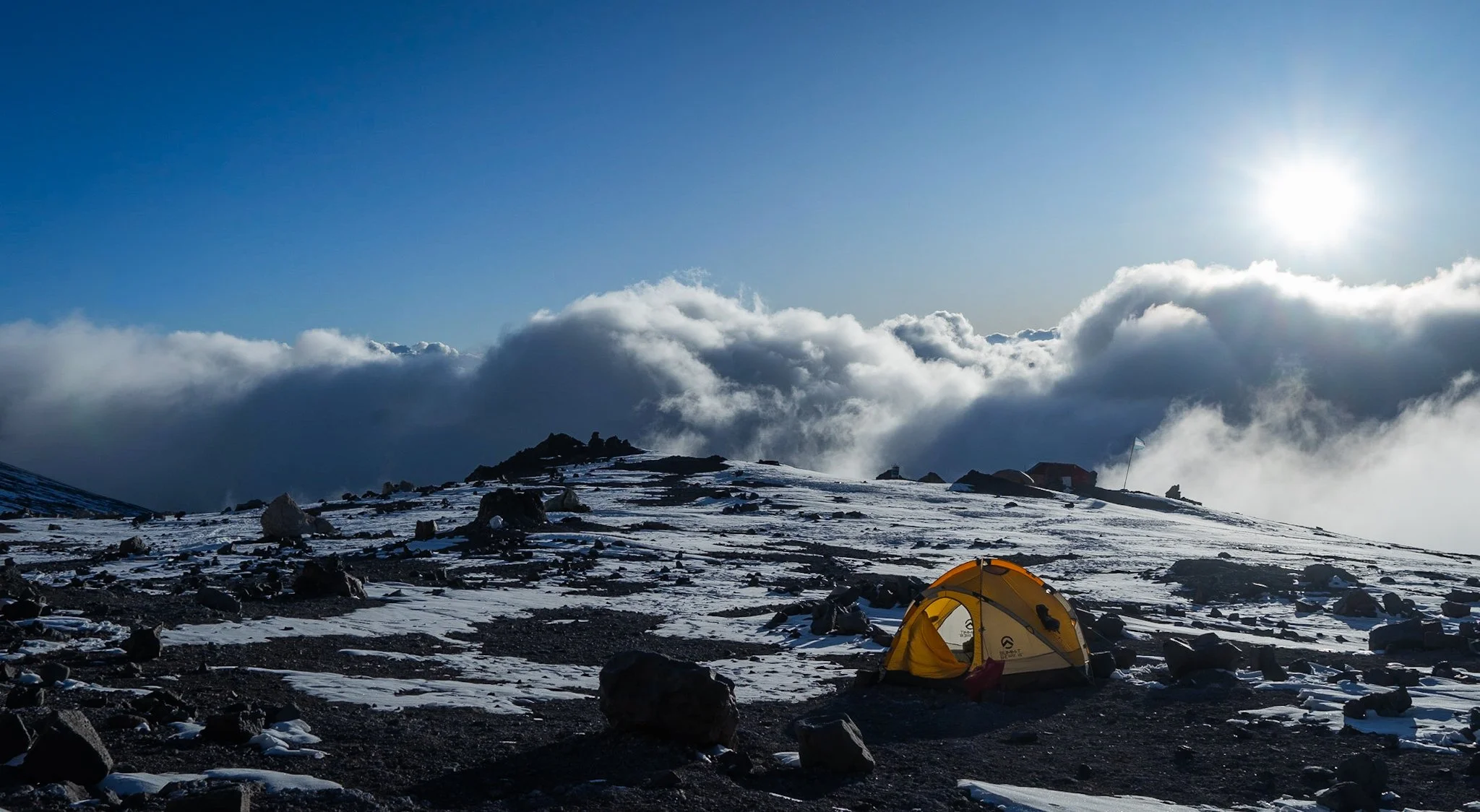THE CASE OF E-COLI AT 5000 METERS
BOILING WATER IN HIGH ALTITUDE
At sea level, the boiling temperature of water is 100°C or 212°F. As you begin to increase in elevation, the boiling point of water begins to decrease resultant from a decrease in atmospheric pressure. In order to adequately kill any bacteria that may exist in your water source, water should be boiled for longer when in altitude vs if you were at sea level.
THE SECOND HIGH CAMP
The day before we were scheduled to begin the ascent from from the first high camp to the second, we were informed by our guides that there was some unanticipated water scarcity at the next camp. Because of this, we needed to carry up as much water as we could, using any spare hydration bladders and any other spare bottles we had on us so that we could build an adequate and necessary water supply. This seemed slightly unusual but we nonetheless went along with the advice of our experienced leaders. When we arrived at the second high camp, we spent the remainder of the day resting. We would also spend the following day to rest as well in order to acclimatize to these new altitudes. Tthis was the first point of the trip where we had crossed above the 5000m mark.
Our first morning waking up at high camp two, we were briefed by our guides that the day’s itinerary would entail searching for more water from nearby lakes. By this stage, most of us already depleted our stash that we had carried up the previous day. For breakfast we were served hot tea and we filled up our water bottles, both of which we used water supplies by our guides, sourced from melted snow they had collected earlier that morning. With our debrief over, we set off on our walk in the search for some H2O.
Upon reaching the first of two lakes in the area, it became apparent that collecting new water would not be an easy feat. The water of the lake had frozen over from the extreme temperatures and a thick sheet of ice around 5 inches deep covered the liquid. The attempts to penetrate through the ice were futile and our guides eventually gave up hope on this particular source after about 30 minutes of digging. There was fortunately a second lake another 20 minutes further from our position and despite some initial and similar setbacks, we were eventually able to pierce through the frosted covering of this one successfully. We spent the next few hours filling up every empty container we had on us before returning to our campsite. We were welcomed back with a pizza lunch, prepared by the sole guide who had stayed behind and as we ate our food and laughed away, we began to guzzle down our well earned and newly acquired source of hydration.
THE ONSET OF AN EPEDEMIC
After lunch we were given some free time to rest. My tent mate, Winston, retreated back to our shared quarters to take a nap while I spent the next few hours exploring the camp site. Upon my return, Winston would ask me how my stomach was feeling. His had not been doing so great. Whilst mine was fine at the time, it took one nap, two hours and three trips to the toilet to realize that mine too was far from fine. We called out to our neighboring tent to see if they were experiencing anything similar and soon received responses from the wider camp affirming congruent symptoms. One of our guides was quickly called over to us where, upon learning of what had taken place, let out a series of loud, audibly profanities before quickly running back to inform the other guides. The worst case scenario was confirmed and it was evident that our entire camp had fallen victim to a stomach virus.
Our initial reaction was to blame our water source from the lake water we had all just drank. This was refuted by our guides as, although every single one of us clients had fallen ill, none of them seemed affected despite having also drank the same water. We argued that given they were local, their resistance to the bacteria was stronger than us foreigners. Winston and I were far more skeptical that the culprit was in fact the melted snow we had drunk earlier in the morning. We speculated that it had not been adequately boiled and instead was simply melted before consumption, failing to rid it of the impurities it would have accumulated from our surroundings. Regardless of the cause, there was no changing the fact that our stomachs were in dire straights. We were scheduled to push to high camp three the following morning, where we would spend less than 24 hours there before attempting the climb to the summit. Our guides’ tentative plan was to continue with this schedule and to press on despite our ailments. Seemingly unempathetic, we were told that this plan of attack was necessary in order to capitalize on an upcoming weather window. We were recommended to try and get as much rest as we could for the remainder of the day and assess how we felt in the morning. Nauseated and frustrated, we each curled up in our sleeping bags and attempted to sleep off whatever we had contracted. Things, however, were not looking great.
THE NEXT 24 HOURS
Awakening the next morning, it was apparent that we were in no shape to go anywhere. Throughout the remainder of the previous day and its night that followed, we had each taken turns to rotate though and decimate the one and only shared toilet tent and the sight of it was simply ghastly. There was shit literally everywhere. There was shit on the ground, there was shit on the unused toilet paper rolls, there was shit on the hand sanitizer bottle. There was even shit on the walls (how??). To call the state of the tent “grim” was an understatement. Additionally, the number of casualties in our group had now spread beyond just us clients with two out of three of our guides now also falling ill. One member in our team had been in contact (via a GPS connection) with her doctor friend throughout the ordeal. We would learn we all had potentially fallen victim to a case E-Coli; the result of drinking contaminated water and something that was not unprecedented in the high camps of Aconcagua. We were recommended by the doctor to commence a course of antibiotics as soon as we could, subject to if we had brought them.
With virtually our entire team out of commission, our day’s scheduled departure to the next high camp was canceled. We would use one of our buffer days (our expedition included a total of three, typically utilized for inclimate weather) to rest up as much as possible. We were all extremely dehydrated, exhausted and anxious for the days to come. We spent the remainder of the day in bed, trying our best to conserve energy and recover, while simultaneously praying that this didn’t mean the premature and unanticipated conclusion to our Aconcagua journey.
THE NEXT MORNING
As the sun rose the following morning, breaking us out of our slumber, by some miracle we ended up feeling a little better. Perhaps it was the previous day’s rest, perhaps it was the antibiotics that most of us had started on. Perhaps it was a combination of the two. Although we weren’t at 100%, we seemed well enough to continue onward and upward which meant there was still hope for the team’s summit bid after all. Unfortunately this was not the case for Winston. He was exhausted, weakened from the past 24 hours and was homesick. High camp two would be the highest point Winston would reach on this expedition and he made the difficult decision to start his descent from there. He would join another trekking group who was on their way down from the summit that same day and would rendezvous with us back at base camp in a few days time. For the rest of us, we would recommence our ascent up to the next high camp. It had been 14 days since beginning the expedition and 36 hours since contracting E-Coli. Less than 24 hours stood between us and our attempt to get to the highest point in South America.


